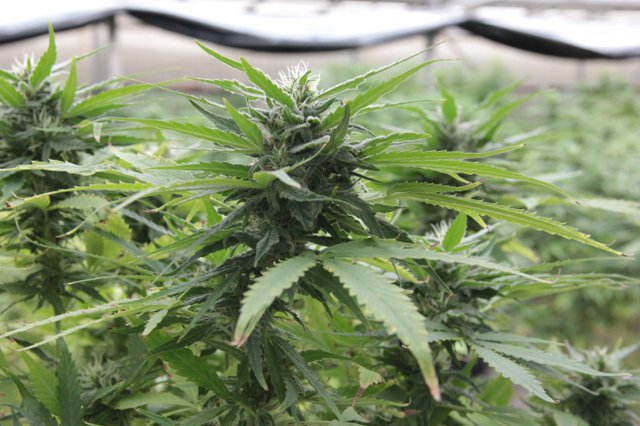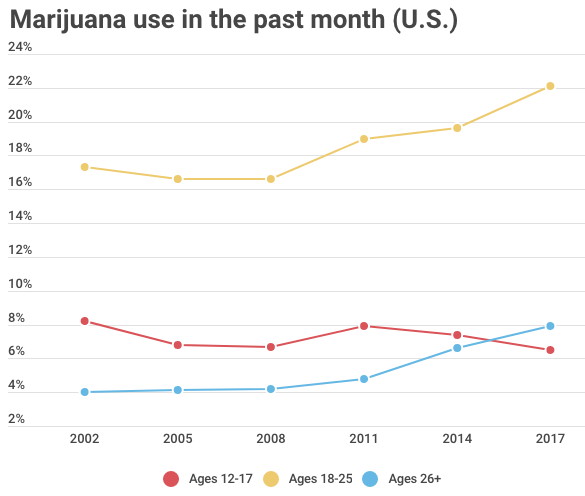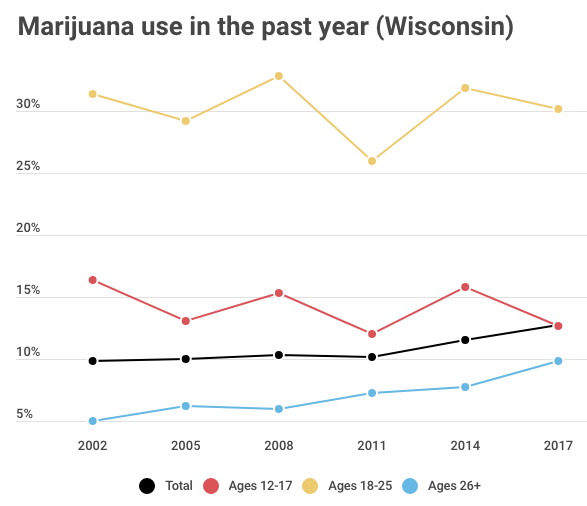By Jean-Gabriel Fernandez

Photo Credit: Jean-Gabriel Fernandez
The
National Survey on Drug Use and Health is an annual study gathering
data about drug use, including marijuana, led by the Substance Abuse and
Mental Health Services Administration (SAMHSA). Currently, data ranging
from 2002 to 2017 is available to the public, and it shows several
crucial points:
Adult use of marijuana is increasing
In 2017, 14.5% of Americans ages 12 and older had used marijuana in the past year. In 2002, SAMHSA had found that 10.71% of people in the same demographic group used marijuana in the past year; that’s a 35% increase in 15 years. The West Coast is the most pot-friendly region, while the South, apparently, has the lowest rates of use.Obviously, states where cannabis is legal have the highest rates. Oregon is leading, with 26.51% of its population using marijuana in the past year, followed by Washington, D.C., and Colorado. Utah is the state with the lowest reported rate of use, but even there, 10.4% of the population consumes pot at least somewhat regularly. Marijuana use has only risen by 2% in Utah since 2002, but it has doubled in Oregon in that same time frame.
Youth use is declining
The National Survey highlights the massive differences between the different age groups. Americans between the ages of 18 and 25 are by far the largest clientele of marijuana; historically, teenagers are second, followed by people ages 26 and up. This status quo has actually changed in the past few years: adults 26 and older have just surpassed teenagers in rates of regular marijuana use in 2016.
While teen use of marijuana started declining rapidly since 2012, adult use of marijuana has been steadily increasing at the same time. Consumption of marijuana in the past month was twice as prevalent among teenagers as it was among adult in 2002 (8.2% and 4%, respectively), but adult use rates doubled while teen use fell by a quarter since.
It’s interesting to note that youth usage of cannabis has started its decline precisely when Colorado and Washington legalized recreational cannabis. We can observe a correlation, but we can’t assume causation, though it appears likely that legal cannabis—being inaccessible to minors through legal means and harder to find on the black market of legal states—has participated to this decline.
Wisconsin follows the national trends
Although the total increase in cannabis consumption in Wisconsin is smaller than the national average (only 3%—from 9.8% in 2002 to 12.7% in 2017), we follow the trends of public acceptance and use of the substance. Marijuana use has nearly doubled among older people and was cut by a third among teenagers.In 2017, SAMHSA found that 30.13% of young adults (ages 18-25) in Wisconsin consumed cannabis in the past year; nearly a third of the age group. Although it places our state solidly in the average when it comes to pot’s popularity among young adults, states like Vermont and Oregon, where 50.08% and 47.57% of that age group use cannabis regularly, respectively, are still far ahead.

Perceptions of marijuana are changing fast
SAMHSA polled people on their perceptions of the risks of smoking marijuana once a month.In 2002, 39.3% of Americans believed it carried a “great risk,” which fell to only 26.91% of Americans 15 years later. Nowadays, the percentage of young adults who fear marijuana falls into the single digits in some states; for example, only 6.83% of Vermonters ages 18-25 think smoking weed is dangerous. Wisconsin is also one of the states with the lowest fear of marijuana, well below the national average.
Interestingly enough, nearly one in two Americans consider that binge drinking regularly carries a great risk; nearly double what was found for concerns about regular marijuana use.
Wisconsin distinguishes itself by being one of three states—along with Iowa and Montana—to fear alcohol use the least. It appears that Wisconsinites just don’t fear the consequences of drug use, be it alcohol or marijuana.

No comments:
Post a Comment